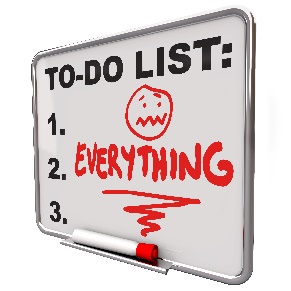I don’t need to tell you that things are busy at work. You know it, feel it, live it. There is more work and fewer people to do the work. Your email box has reached its limit. You are continually asked to go faster. You are connected during work, after work, and perhaps on your vacation. You are bombarded with new information, processes, and industry breakthroughs.
 No matter your industry, the story is the same. Restructuring, reorganizations, market changes, technology innovations and globalization have resulted in more work to be done by fewer people in shorter time-frames. As a result, many of us relay on three strategies to manage:
No matter your industry, the story is the same. Restructuring, reorganizations, market changes, technology innovations and globalization have resulted in more work to be done by fewer people in shorter time-frames. As a result, many of us relay on three strategies to manage:
- WE GO FASTER
We speed up, sometimes to warp speed. We dash between meetings. We charge through our work and personal life at top speed, barely able some days to catch our breath.
- WE HUNKER DOWN
We come in early. We stay late. We eat lunch at our desk. Or we skip lunch. We take work home. We continue to find time wherever we can to squeeze in one more thing.
- WE FIND PRODUCTIVITY SHORTCUTS
We multi-task. We automate our inbox. We download new apps and implement new technology. We search for ways to shave minutes, and sometimes seconds, from any “to do” list.
Any of these tactics, in the short term, can work. There are days we need to speed things up a bit. There are periods of time where we just need to hunker down and get through a busy patch. And who does not love to find ways to do routine tasks quicker and easier?
Our problem is that we are in a perpetual state of change, speed and turbulence. No matter how fast we go, we are unable to go fast enough to outrun it. We can only stretch ourselves so thin until we have nothing more to give. None of these three tactics are sustainable over time, especially when just as we speed up, our world does too. We are perpetually chasing something that we have no hopes of ever catching, let along conquering. We are the proverbial dog chasing the car, never able to catch it but caught up in the chase with every car that passes by.
Unlike the dog, we do not need to be trapped in chasing cars forever. Yet that requires the search for sustainable solutions. Ones that enable us to do what is most important while at the same time maintaining our physical, emotional, and social health. To do that requires a radical rethinking of our work, what matters, and then great courage as we shed what no longer serves us well.
There are many ways we can radically rethink our lives and our work, and I’m going to focus on one, here: shedding. The notion comes from evergreens which shed old foliage incrementally yet constantly. This enables them to continually bring on new and healthy growth and makes them one of the hardiest plant species on earth. Due to the one-needle-at-a-time nature of this process, we never notice that this is happening, yet the deep carpet of pine needles on the forest floor are testament to just how much has been shed. Imperceptibly. Painlessly. Continually.
In a culture in which more is perceived as the goal, asking what we can shed seems a bit heretical. And so, we add work but never ask what work should go away. We are excited to bring on the new, yet never intentionally cull the old. We add new products and/or services, but fail to decommission the old ones; allowing them to slide into a slow death.
In my next post, I’ll go deeper into things you might shed. But for now, consider these questions:
- What is your typical mental state of mind? What can you do to nurture a calm, peaceful and focused state of mind more often?
- How much rest are you allowing yourself, including both sleep and “down time”? Is it adequate for your needs or do you find yourself tired and exhausted frequently?
- When was the last time you really unplugged from work? From social media? How might you schedule time (even a day) to do that?
- How many hours a week are you devoting to work? Is this a sustainable pace?
- Are you able to focus on one thing at a time? If not, what are the prices you pay for multi-tasking?
- Are you able to see things through to completion or do you have a multitude of projects in various states of progression? What is impact of having so much in motion at one time?
I’ve devoted an entire chapter in my book, The Leader’s Guide to Turbulent Times, to the concept of shedding. If you want a deeper dive, see Chapter 13.




